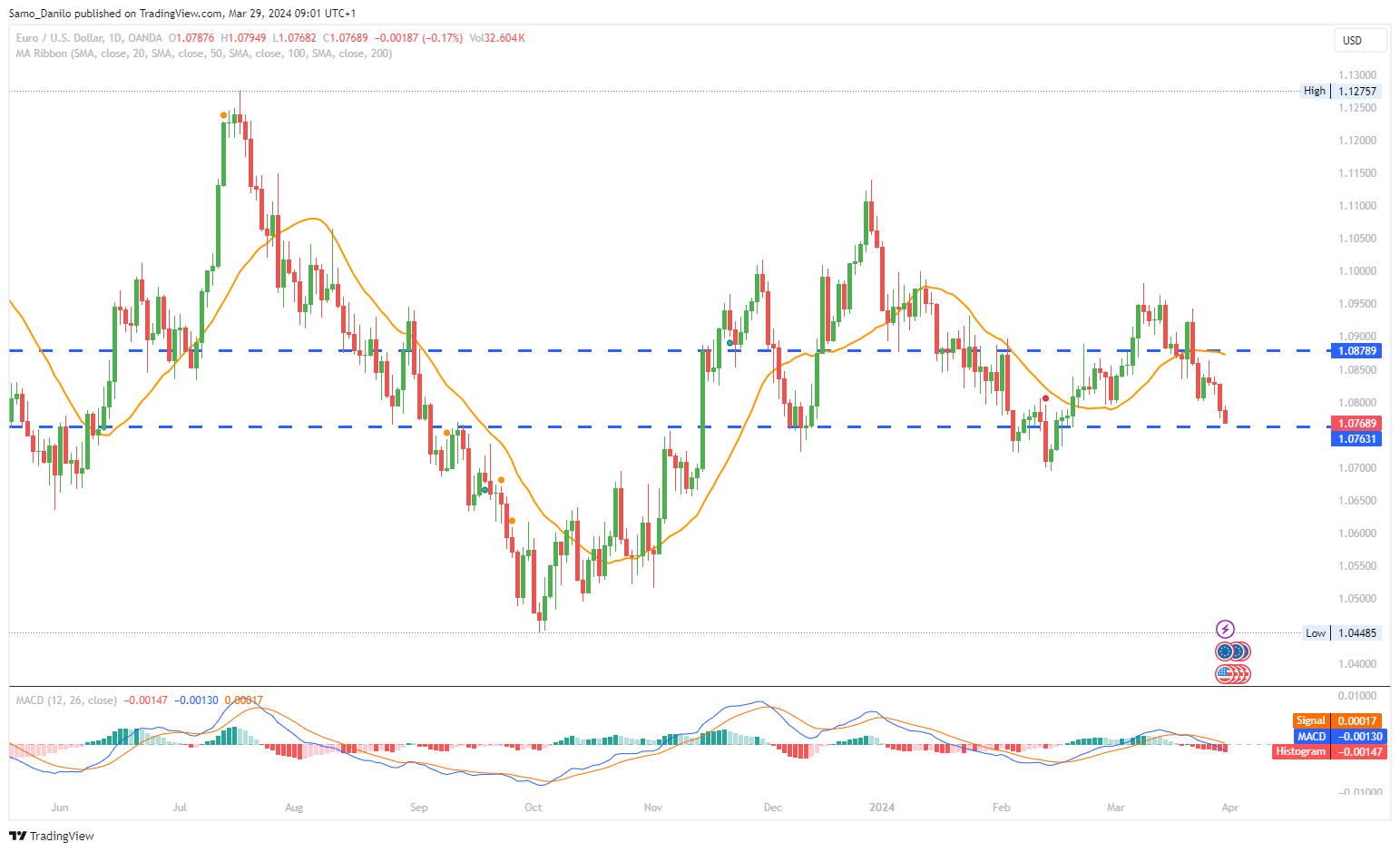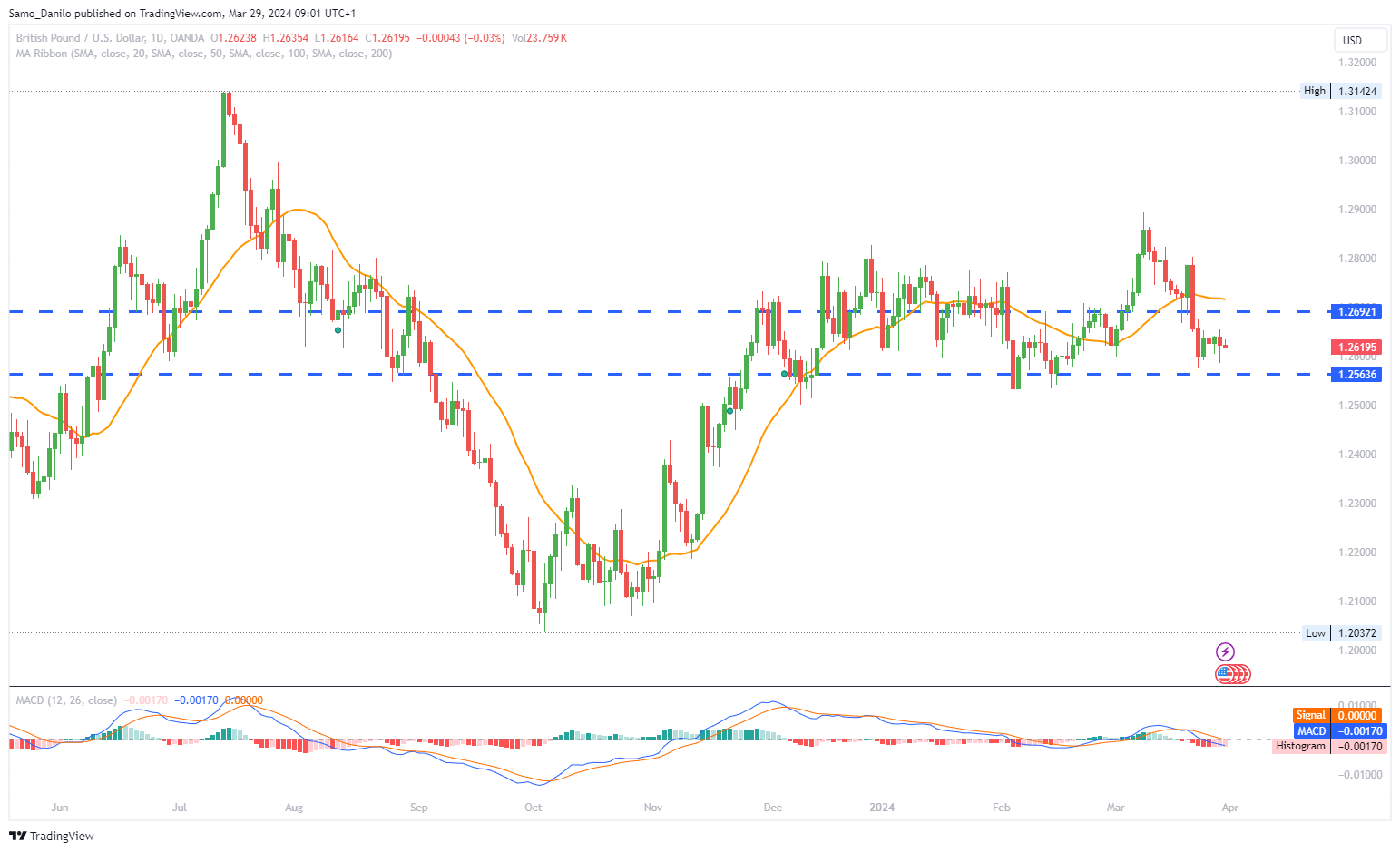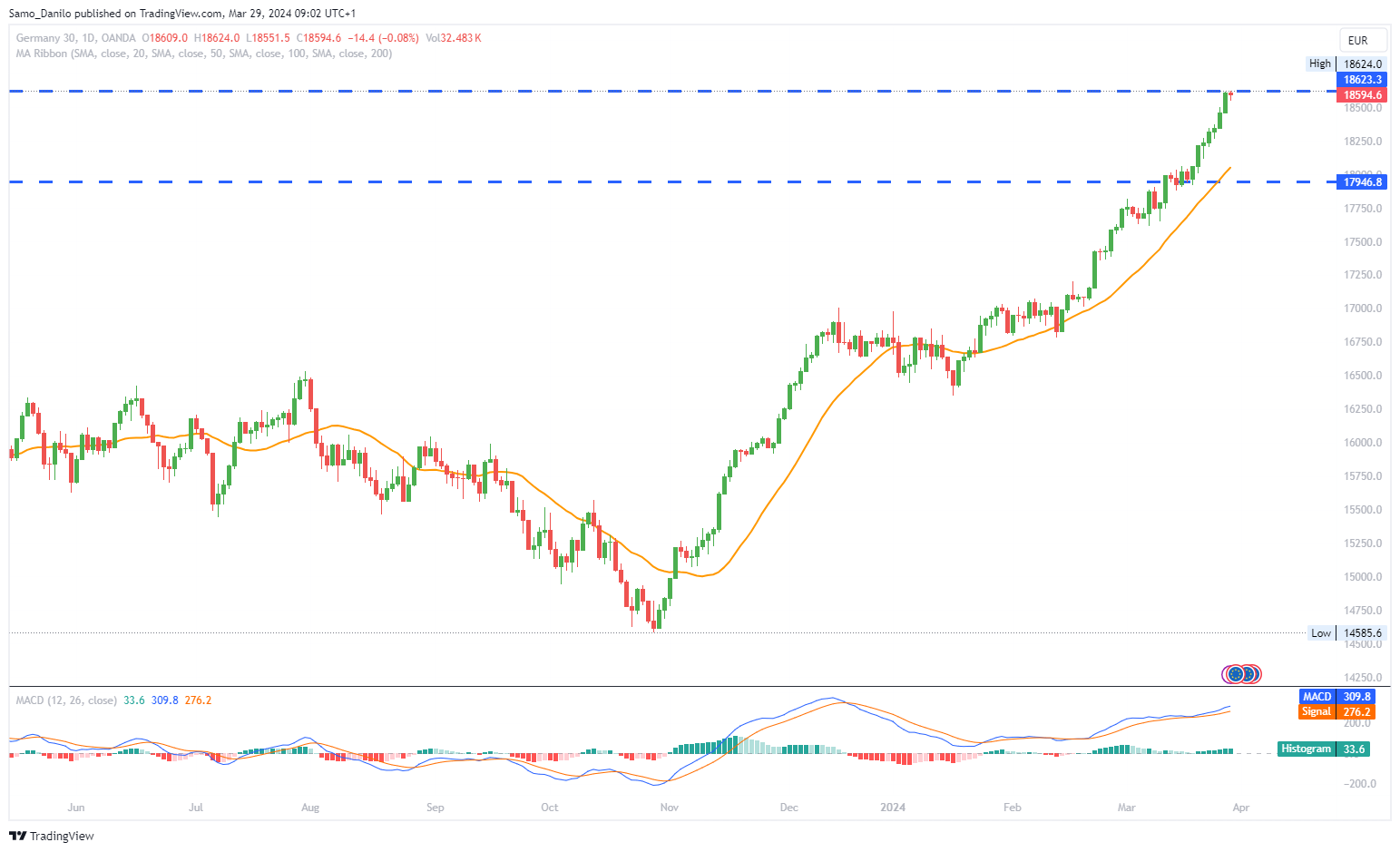EURUSD
- Continued Downward Trend: EUR/USD extends its decline for the fourth consecutive day, driven by a robust US Dollar strengthened by hawkish sentiments surrounding the Federal Reserve and expectations of sustained higher interest rates. The pair struggles amid this USD strength, facing pressure to the downside.
- Hawkish Fed Comments: The US Dollar gains support from hawkish remarks made by Federal Reserve Governor Chris Waller, affirming the central bank's patient stance towards rate adjustments. These comments bolster confidence in the USD, contributing to the downward pressure on EUR/USD.
- ECB Member Commentary: Despite comments from European Central Bank (ECB) Board member Fabio Panetta indicating diminishing risks to price stability in the Euro Zone and conditions for easing monetary policy, the Euro fails to find support against the resurgent US Dollar, highlighting the prevailing strength of the USD.
- US Economic Data: Upward revision of the final estimate of Q4 Gross Domestic Product (GDP) to 3.4% and better-than-expected Initial Jobless Claims for the week ended March 22 at 210K provide additional momentum to the US Dollar, further weighing on EUR/USD.
- Holiday Market Closure and Key US Data: With most markets closed on Friday due to the Easter Holiday, attention turns to the US release of the core Personal Consumption Expenditures (PCE) Price Index, a crucial inflation indicator favored by the Fed. Expectations are for stability at 2.8% Year over Year, which could influence future market sentiment and USD strength.
Closing statement: EUR/USD faces sustained downward pressure amidst a strengthening US Dollar driven by hawkish Federal Reserve sentiments and positive US economic data. Despite comments indicating potential easing of monetary policy from ECB officials, the Euro struggles to find support against the robust USD. As markets anticipate the US PCE Price Index release amid holiday closures, EUR/USD remains under scrutiny, with further USD strength potentially dictating near-term movements.
GBPUSD
- Weaker Pound Sterling: GBP/USD trades lower around 1.2620 in the early European session on Friday, reflecting a decline in the Pound Sterling. Speculation grows regarding the initiation of a rate-cut cycle by the Bank of England (BoE), contributing to the downward pressure on the GBP.
- Hawkish Fed Sentiments: Federal Reserve (Fed) Governor Christopher Waller's remarks on Wednesday, indicating the Fed's reluctance to cut rates amidst persistent inflation concerns, bolstered confidence in the US Dollar. This stance contrasts with expectations of potential rate cuts by the BoE, further weakening the GBP against the USD.
- Upward Revision in US Consumer Sentiment: The March Michigan Consumer Sentiment Index sees an upward revision to 79.4, surpassing the preliminary estimate of 76.5. This positive data release reinforces confidence in the US economic outlook, providing additional support to the USD and contributing to GBP/USD weakness.
- BoE Governor's Comments: BoE Governor Andrew Bailey's statement affirming that interest rate cuts will be 'in play' at future BoE policy meetings adds to the downward pressure on the Pound Sterling. Market participants interpret this as a signal of potential monetary policy easing by the BoE, contrasting with the Fed's stance.
- Holiday Trading and US Inflation Data: With muted market activity expected on Good Friday, attention turns to the US release of the Core Personal Consumption Expenditures (PCE) Price Index. The Fed's preferred inflation gauge is anticipated to remain stable at 2.8% Year over Year, influencing market sentiment and the GBP/USD exchange rate.
| SMA (20) | Slightly Rising |
| |
| RSI (14) | Falling |
|
|
| MACD (12, 26, 9) | Falling |
|
|
Closing statement: GBP/USD faces downward pressure amid speculation of a potential rate-cut cycle by the Bank of England, contrasting with the Federal Reserve's reluctance to adjust rates amidst inflation concerns. Upward revision in US consumer sentiment data further strengthens the US Dollar, contributing to GBP weakness. As markets anticipate the US PCE Price Index release amidst holiday trading, GBP/USD remains vulnerable to further fluctuations, with near-term movements influenced by USD strength and BoE monetary policy outlook.
GOLD
- Steady Gold Price at All-Time High: Gold maintains its position near an all-time high of $2,236, experiencing limited trading activity amid thin market conditions on Good Friday. The precious metal lacks significant trading impetus as major world markets, including the United States, observe the holiday, contributing to subdued volatility in gold prices.
- Holiday-Thinned Market Conditions: With most major world markets closed for Good Friday, market activity surrounding gold remains highly subdued. The absence of major trading participants limits trading volumes and exacerbates the lack of significant price movements in the gold market.
- Technical Outlook and Upside Potential: From a technical standpoint, gold price still exhibits potential upside, with the Bull Flag target, projected around $2,250, likely to motivate buyers. Traders are also eyeing the $2,300 round level as the next significant resistance level for gold.
- US Economic Data Impact: Thursday's upward revision to the fourth-quarter annualized US Gross Domestic Product (GDP) data, from 3.2% to 3.4%, contributes to the strength of the US Dollar. The positive economic data release reinforces confidence in the US economy and bolsters the US Dollar against gold.
- Focus on US PCE Price Index: Market participants eagerly await the release of the US Personal Consumption Expenditures (PCE) Price Index later on Friday. The data release is expected to provide insights into the market's pricing of a potential US Federal Reserve (Fed) interest rate cut in June, influencing investor sentiment and gold price movements.
| SMA (20) | Rising |
|
|
| RSI (14) | Slightly Rising |
| |
| MACD (12, 26, 9) | Rising |
|
|
Closing statement: Gold maintains its position near an all-time high amidst subdued trading activity on Good Friday, with limited trading impetus and volatility due to holiday-thinned market conditions. While technical indicators suggest potential upside for gold, market focus remains on the upcoming US PCE Price Index release to gauge expectations of a Federal Reserve interest rate cut in June, which could influence gold price movements in the near term.
CRUDE OIL
- WTI Oil Price Settles Higher: West Texas Intermediate (WTI) oil price concludes the trading session on Thursday with an uptick, reaching $83.40 per barrel. The increase in crude oil prices reflects ongoing market dynamics and factors influencing supply and demand.
- OPEC+ Production Cuts Support Prices: The rise in crude oil prices is primarily attributed to expectations that the Organization of the Petroleum Exporting Countries and its allies (OPEC+) will maintain their existing production cuts. Investors anticipate that OPEC+ will uphold its oil output policies until a full ministerial gathering scheduled for June, despite heightened geopolitical risks.
- Focus on OPEC Joint Monitoring Meeting: Market participants are closely monitoring the upcoming Joint Monitoring Ministerial Committee meeting of OPEC, scheduled for next week. While geopolitical tensions raise concerns about potential supply disruptions, it is unlikely that OPEC+ will make immediate changes to their production policies until the June meeting.
- EIA Report Indicates Inventory Build: The Energy Information Administration (EIA) report reveals a weekly increase in US crude inventories. For the week ending March 22, the EIA Crude Oil Stocks Change reported a build of 3.165 million barrels in stock, contributing to market sentiment surrounding crude oil prices.
- Logistical Challenges Following Bridge Collapse: In the aftermath of the collapse of the Francis Scott Key Bridge on Tuesday, fuel suppliers in Baltimore are anticipated to face trucking delays and logistical challenges. The incident could impact the transportation and distribution of crude oil and petroleum products in the region, potentially affecting market dynamics.
| SMA (20) | Rising |
|
|
| RSI (14) | Slightly Rising |
| |
| MACD (12, 26, 9) | Slightly Rising |
|
Closing statement: Crude oil prices experience a slight uptick, with WTI settling higher at $83.40 per barrel on Thursday. Expectations of ongoing production cuts by OPEC+ support prices, although geopolitical tensions and inventory build contribute to market uncertainty. Attention remains on the upcoming OPEC Joint Monitoring Ministerial Committee meeting and the aftermath of the bridge collapse in Baltimore, which could impact logistical operations and supply dynamics in the crude oil market.
DAX
- ECB's Divergent Policy Stance: The European Central Bank (ECB) signals a more dovish stance compared to the Federal Reserve, with expectations for four rate cuts versus 2 or 3 by the Fed. This divergence favors the US Dollar in currency markets, impacting European equities like the DAX.
- Weak Domestic Demand in Europe: Europe reports subdued domestic demand, as evidenced by Germany's retail sales decline of 1.9% in February, marking the fourth consecutive month of decline. Year-on-year, retail sales fell by 2.7%, reflecting ongoing economic challenges.
- DAX Outperformance: Despite weak domestic demand, the DAX index has surged 10% since the beginning of the year, outperforming indices like the Dow Jones. The DAX has seen consistent weekly gains since February, reaching record highs along the way.
- Euro's Impact on DAX: The weakness of the euro has contributed to the DAX's outperformance, although it's not the sole driver. A weaker euro benefits German exporters, boosting their competitiveness in international markets and bolstering DAX-listed companies.
- ECB's Policy Impact: The ECB's proactive approach to easing policy contrasts with the Fed's stance, potentially exerting downward pressure on the euro and supporting German equity exporters. This dynamic creates a seesaw effect for Germany, where ECB policy decisions influence market sentiment and DAX performance.
| SMA (20) | Rising |
|
|
| RSI (14) | Rising |
|
|
| MACD (12, 26, 9) | Rising |
|
|
Closing statement: The DAX continues its impressive performance, gaining 10% since the beginning of the year despite weak domestic demand in Europe. The ECB's more dovish policy stance, coupled with the euro's weakness and favourable export conditions, supports the DAX's outperformance. However, the impact of divergent central bank policies remains a key factor influencing market sentiment and DAX dynamics.





